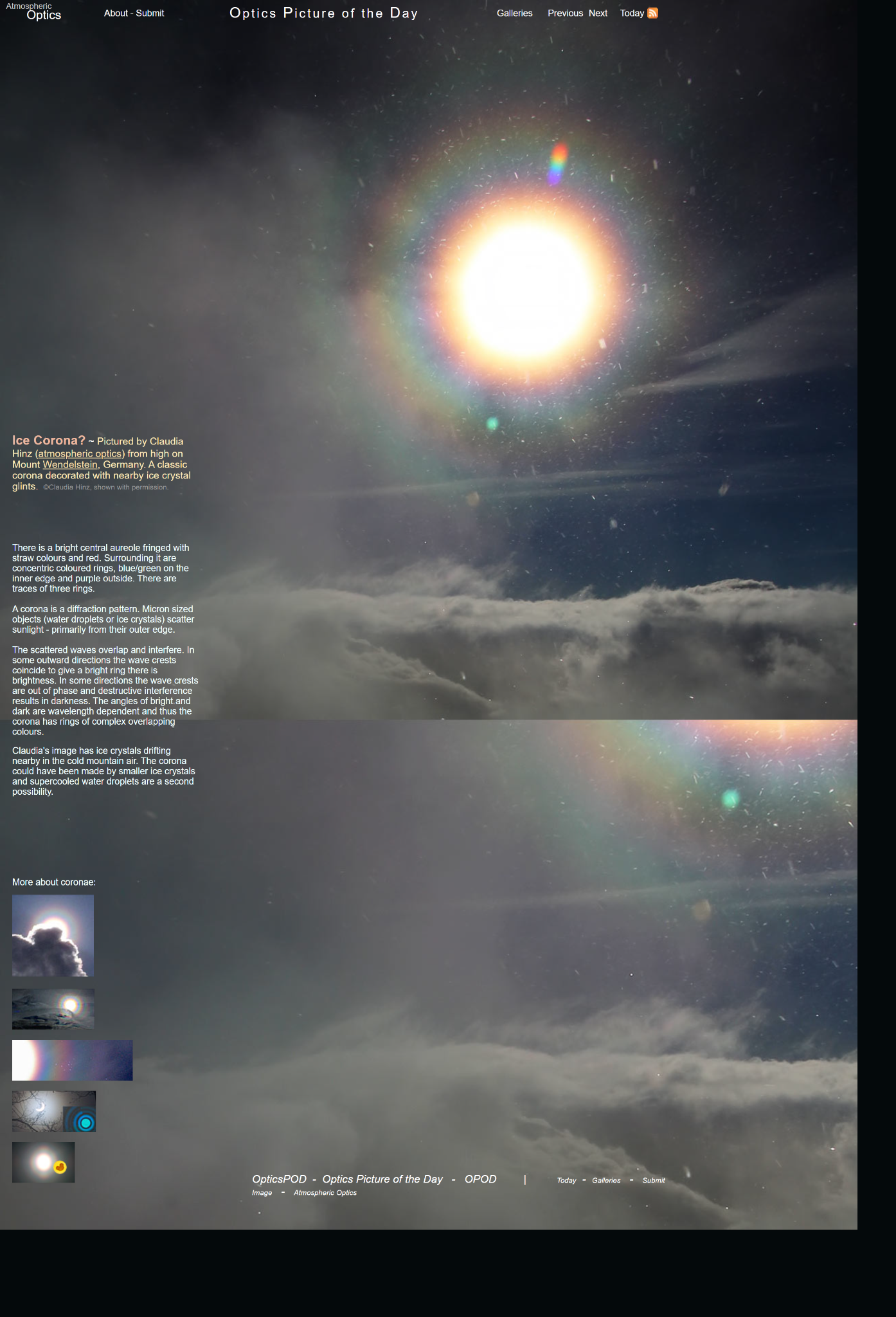OPOD - Ice Corona?
Ice Corona: A Spectacular Atmospheric Phenomenon
Ice corona is a captivating atmospheric optics phenomenon that occurs when sunlight interacts with ice crystals or supercooled water droplets in the atmosphere. These intricate displays of light can be observed in various locations around the world, including high-altitude areas such as Mount Wendelstein in Germany. One such mesmerizing ice corona was captured by Claudia Hinz, showcasing a classic corona adorned with nearby ice crystal glints.
The Elements of an Ice Corona
Upon closer examination of Claudia's image, we can discern several distinct features that compose an ice corona. At its core, there is a bright central aureole surrounded by concentric colored rings. The inner edge of the rings exhibits a blue/green hue, while the outer edge takes on a purple shade. Additionally, faint traces of three rings can be observed, adding to the complexity and beauty of the corona.
Understanding the Science Behind Ice Coronas
At its essence, a corona is a diffraction pattern resulting from the scattering of sunlight by micron-sized objects such as water droplets or ice crystals. These tiny particles act as miniature prisms, dispersing light and creating an intricate interplay of waves and interference. When sunlight encounters these particles, the scattered waves overlap and either reinforce or cancel each other out, depending on their relative phases.
In certain outward directions, the wave crests align, resulting in constructive interference and the formation of bright rings within the corona. Conversely, in other directions, the wave crests are out of phase, leading to destructive interference and the appearance of dark regions. The specific angles at which these bright and dark areas occur depend on the wavelength of light, thus giving rise to the complex overlapping colors within the corona.
Factors Influencing Ice Corona Formation
The formation of ice coronas is influenced by various factors, including the size and shape of the ice crystals or water droplets involved. In Claudia's image, the presence of drifting ice crystals in the cold mountain air suggests that they may have played a role in creating the observed corona. However, it is important to note that smaller ice crystals and supercooled water droplets can also contribute to the formation of these captivating optical phenomena.
The Enigmatic Beauty of Ice Coronas
Ice coronas serve as a testament to the awe-inspiring beauty and complexity of the natural world. The intricate interplay of light and ice crystals creates a visual spectacle that never fails to captivate observers. Each ice corona is unique, with its own arrangement of colors, rings, and glints, making every sighting a truly special experience.
Conclusion
In conclusion, ice coronas are remarkable atmospheric optics phenomena that occur when sunlight interacts with ice crystals or supercooled water droplets. These ethereal displays of light can be observed in various locations, including high-altitude areas such as Mount Wendelstein in Germany. By understanding the science behind ice coronas and appreciating their enigmatic beauty, we can gain a deeper appreciation for the wonders of our natural world. So, keep your eyes to the sky and be ready to witness the mesmerizing dance of light in an ice corona.

Ice Corona? ~ Pictured by Claudia Hinz (atmospheric optics) from high on Mount Wendelstein, Germany. A classic corona decorated with nearby ice crystal glints. ©Claudia Hinz, shown with permission.
There is a bright central aureole fringed with straw colours and red. Surrounding it are concentric coloured rings, blue/green on the inner edge and purple outside. There are traces of three rings.
A corona is a diffraction pattern. Micron sized objects (water droplets or ice crystals) scatter sunlight - primarily from their outer edge.
The scattered waves overlap and interfere. In some outward directions the wave crests coincide to give a bright ring there is brightness. In some directions the wave crests are out of phase and destructive interference results in darkness. The angles of bright and dark are wavelength dependent and thus the corona has rings of complex overlapping colours.
Claudia's image has ice crystals drifting nearby in the cold mountain air. The corona could have been made by smaller ice crystals and supercooled water droplets are a second possibility.

Note: this article has been automatically converted from the old site and may not appear as intended. You can find the original article here.
Reference Atmospheric Optics
If you use any of the definitions, information, or data presented on Atmospheric Optics, please copy the link or reference below to properly credit us as the reference source. Thank you!
-
<a href="https://atoptics.co.uk/blog/opod-ice-corona/">OPOD - Ice Corona?</a>
-
"OPOD - Ice Corona?". Atmospheric Optics. Accessed on November 26, 2024. https://atoptics.co.uk/blog/opod-ice-corona/.
-
"OPOD - Ice Corona?". Atmospheric Optics, https://atoptics.co.uk/blog/opod-ice-corona/. Accessed 26 November, 2024
-
OPOD - Ice Corona?. Atmospheric Optics. Retrieved from https://atoptics.co.uk/blog/opod-ice-corona/.